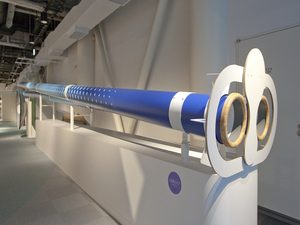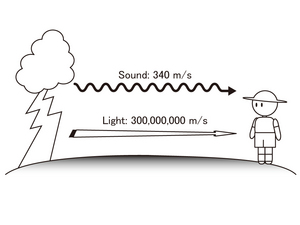Nagoya City Science Museum
TOP > Exhibition Guide > Keyword Search > Starting with "E" > echo > Echo Tube
Echo Tube



Purpose of Exhibition
There are two pipes. Clap your hands or raise your voice. The lengths of the two pipes are different, whereas their diameters and materials being the same. Can you tell the difference in reverberation?
Additional Knowledge
Sound generated in front of the pipe passes through the pipe, hitting the edge of the opposite side. At this moment, the speed of sound is approximately 340 meters per second.
There are two pipes, a short one which is 17 meters long, and long one which is double that at 34 m. For the shorter pipe, the sound bounces back and forth from a distance of 34 meters. It takes 0.1 second. On the other hand, with the longer pipe, the time double to 0.2 seconds. The sound that came out first comes back after 0.1 or 0.2 seconds. The reverberation is different in the two pipes.
When mountain climbing and the like, if you call out "Yee-ha!" toward the next mountain, "Yee-ha!" can be heard few seconds later. This is the first "Yee-ha!" reflected back, and is called the "echo".
Out in the field, when there is a rather loud sound, lightning is one of them. Thunder rumbles soon after. Sound and lighting are made at the same time. Light progresses at 300,000 kilometers per second, which is equivalent to 7 and a half turns of the globe. With a speed of 340 meters per second for thunder, it is very slow compared with light.
Thus, from first seeing the lightning to hearing the rumble, it takes time. You can calculate the distance between yourself and the lightning. For example, if you hear rumbling 10 seconds after lightning, the distance is calculated as 340 x 10, that means the lightening is at a 3400 meters distance away.
In a dry atmospere whose pressure is 1 atm, the velocity of sound transmission can be expressed by a formula 331.5 + 0.61t , where t is the temperature of air.
Calculation with this formula and the air temperature in Nagoya City indicates the speed of sound in Nagoya varies from 332 m/s in winter to 350 m/s in summer.
Article by Tetsuro Ojio, curator
